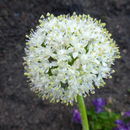Allium cepa, the onion (also called bulb onion or common onion) and the shallot (
A. cepa var.
aggregatum), is a monocot bulbous perennial (often biannual). It is the most widely cultivated species of the genus
Allium, which includes other important species such as garlic (
A. sativum) and leeks (
A. ampeloprasum). The name "wild onion" is applied to various
Alliums. Allium species are among the oldest cultivated crops. Diverse representations in Egyptian artifacts dating to 2700 B.C suggest that onions had been cultivated and in wide use by that time (Fritsch and Friesen 2002). The present species,
A. cepa, is known only from cultivation, but appears to have been domesticated from wild ancestors in the Central Asian mountains (Brewster 1994). Numerous cultivars have been developed for size, form, color, storability, resistance to pests and pathogens, and climatic adaptations. Cultivars are divided into the Common Onion Group (
A. cepa var.
cepa), which contains most of the economically important varieties (including cultivars grown for green or salad onions) and the Aggregatum Group, which includes shallots and potato onions, and typically produce clusters of small bulbs (Brewster 1994). Onions are widely used on cooking in nearly all regions of the world, and have been used in diverse cultures and rituals throughout history. (See Wikipedia article in full entry; additional details in Block 2010 and Brewster 1994.) Onions produce various sulfur-containing compounds (such as cysteine sulfoxide), probably for defense against fungi and insects, that, together with their breakdown products, produce their distinctive odor, flavor, and lachrymatory (tear-stimulating) properties (Brewster 1994). Throughout history, onions have been used in folk medicine for purposes ranging from treating wounds and stomach ailments to treating infertility (Wikipedia 2011). Scientific and pharmacological studies since World War II have found evidence that onions or their derived compounds have antimicrobial and antifungal properties, and may also be of benefit in preventing or treating heart disease and atherosclerosis, diabetes, cancer, and possibly asthma (Brewster 1994, Griffiths et al. 2002). Despite their benefits to humans, onions are toxic to cattle, cats, and dogs, and, to a lesser extent, sheep and goats (Cope 2011, Merck 2011). Consumption by these animals of large amounts of onion may lead to anemia and impaired oxygen transport. Global production of onions in 2008 was second only to tomatoes among horticultural crops: more than 73 million metric tons harvested from 3.6 million hectares. China alone produced more than 20 million metric tons; other leading producers were India, Australia, the United States, Pakistan, and Turkey (FAOSTAT 2011).
A. cepa has escaped cultivation or naturalized in much of eastern North America as well as California and the Pacific Northwest (USDA PLANTS 2011), but generally remains localized. It is classified as a noxious weed in Arkansas (along with all
Alliums). Onions have large cells visible under low magnification, so onion tissue is often used in high school science laboratories for learning about microscope use and cell structure, as shown in this lesson from Rice University (
http://teachertech.rice.edu/Participants/dawsonm/cells/microlab4.htm) and this video of onion cells from YouTube:
http://www.youtube.com/watch?v=Tdch3mxQ4oU.

